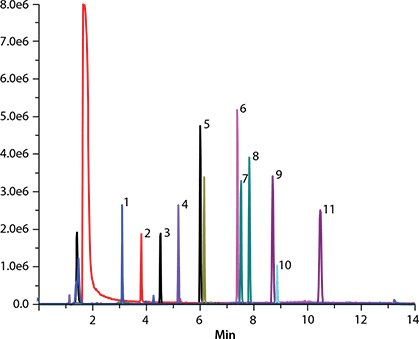Analysis of Isocyanates Using the ASSET™ EZ4-NCO Dry Sampler
Jamie Brown, Emily Barrey, Olga Shimelis, Kristen Schultz
Reporter US Volume 30.3
Introduction
Isocyanates are used as a raw material to produce a number of products such as automotive paints, rigid and spray foam insulation, and furniture. Personal exposure can occur while the products made with isocyanates are being applied, or when the materials are removed by grinding or thermal degradation. Workers who are exposed to these compounds are at risk for respiratory disorders and asthma. The highly reactive nature of the isocyanate compounds and the low occupational exposure limits put high demands on both sampling and analytical techniques for monitoring of isocyanates in air.
The most common devices for sampling isocyanates are impingers and impregnated filters. Impingers are the least desired for personal sampling due to the risk of exposure to solvent vapors during sampling. There are also other issues; such as, glass breakage and difficulty with shipping the needed reagents before and after sampling. Existing impregnated filter devices are safer for the worker to wear, but have known issues, such as:
- Incomplete derivatization of particle bound analytes
- Insufficient capacity and/or breakthrough resulting in underestimation of isocyanate concentration
- Limited range of isocyanate compounds
- Field reagent addition and/or desorption necessary/ recommended
- Unstable reagents and limited shelf-life
The ASSET™ EZ4-NCO sampler (Figure 1) uses dibutyl amine (DBA) derivatization of isocyanates according to ISO 17734-1[1]; the DBA derivatives are very stable, and the derivatization takes place during air sampling so it does not require the use of additional liquids and reagents. The special sampler design ensures that both the vapor phase and particulate isocyanates are captured and derivatized during sampling. ASSET™ samplers can be kept at room temperature for as long as 4 weeks prior to extraction and analysis. The analysis of 10 isocyanate and di-isocyanate compounds can be performed simultaneously using LC-MS or LC-MS-MS detection methods.

Figure 1. ASSET™ EZ4-NCO Dry Sampler
In this study, we investigated the detection limits and the sensitivity of analysis after the ASSET™ samplers were spiked with a mixture of DBA-isocyanate derivatives representing an air concentration of 5 µg/m³ at an assumed sample volume of 24 L (recommended flow range of the sampler is 0.1-0.25 L/min).
Spiking and Extraction of Isocyanates From The Sampler
The DBA-Isocyanate standard solution was used for spiking the ASSET™ sampler at 0.12 µg of each compound investigated; the extraction procedure was then applied. Internal Standards (Deuterated DBA-Isocyanates) are added prior to the extraction to get better quantitation precision and to compensate for any change in the DBA-isocyanate concentration during the extraction process.
- Remove the filter medium from ASSET™ sampler and place into a test tube
- Add 1 mM sulfuric acid, methanol, toluene and deuterated internal standard
- Shake, sonicate, and centrifuge
- Collect all toluene layers and evaporate to dryness
- Collect the top toluene layer, add more toluene, and repeat the extraction
- Dissolve the sample in 1 mL acetonitrile for LC-MS(-MS) analysis
LC-MS Analysis
Calibration standards are prepared by spiking a matrix solution with both DBA-isocyanates and deuterated internal standards. The calibration standards are then taken through the extraction procedure. The concentrations used for calibration in this study were 5-280 ng/mL with respect to underivatized isocyanates. The concentration of internal standard used in the final sample was 20 ng/mL. Table 1 lists the quantitation limits that were established based on the concentration of the extracted samples by using LC-MS and LC-MS/MS.

Figure 2. Chromatogram of DBA Standard (equivalent to 0.20 µg/mL of each underivatized monomer) conditions: column: Ascentis® Express C18, 15 cm x 4.6 mm, 2.7 µm particles (53829-U); mobile phase: (A) 5:95 acetonitrile:water w/ 0.05% formic acid; (B) 95:5 acetonitrile:water w/ 0.05% formic acid; gradient: 40% to 70% B in 3 min; 70% to 90% B in 2 min; hold at 90% for 6 min, 90% to 40% in 0.1 min, hold at 40% for 3.9 min; flow rate: 1 mL/min; column temp.: 35 °C; detector: AB3200 QTrap® MS, ESI(+), SIM; injection: 2 µL
| 1. Isocyanic acid (ICA) 2. Methyl isocyanate (MIC) 3. Ethyl isocyanate (EIC) 4. Propyl isocyanate (PIC) 5. Phenyl isocyanate (PhI) 6. Hexylmethylene diisocyanate (HDI) |
7. 2,6-Toluene diisocyanate (2,6-TDI) 8. 2,4-Toluene diisocyanate (2,4-TDI) 9. Isophorone diisocyanate (isomer 1) (IPDI-1) 10. 4,4’-Methylenediphenyl diisocyanate (MDI) 11. Isophorone diisocyanate (isomer 2) (IPDI-2 |
Recoveries
Overall, the recoveries for spiked filter sample with the DBA derivatives were consistent, ranging from 77.9-125% with RSD’s <16% for MS; and averages of 95.0-117% with RSD’s <9% for MS/MS analytical methods. Spiking the sampler with 0.12 µg of each isocyanate-derivative would equate to 5 µg/m³ air concentration if a 24 liter air sample was taken.
** Recoveries were corrected for a small amount of ICA found in the filter blank sample.
Conclusions
We investigated the performance of the LC-MS and LC-MS-MS methods in the analysis of isocyanates using the new ASSET™ EZ4-NCO Dry Sampler. We found that the analytical method can successfully reach the quantitation limit of 5 ng/mL for most isocyanates in the final sample when LC-MS-MS analysis was used, and the quantitation limit of 10 ng/mL when LC-MS analysis was used. These numbers translate, respectively, to 0.21 µg/m³ of isocyanates and 0.42 µg/m³ in air if a 24 liter air sample was taken. Both LC-MS and LC-MS-MS analysis gave reasonably low LOQs for the method. All 11 compounds were well-resolved chromatographically using a 15 cm Ascentis Express C18 column. The acceptable recoveries for the isocyantes demonstrated the overall efficient performance of the extraction and analytical method.
Featured Products |
|---|
Trademarks
Ascentis is a registered trademark of Sigma-Aldrich Co. LLC
ASSET is a trademark of Sigma-Aldrich Co. LLC
Q TRAP is a registered trademark of Applied Biosystems/MDS SCIEX Instruments MDS Inc.
ISO is a registered trademark of the International Organization for Standardization
References
To continue reading please sign in or create an account.
Don't Have An Account?